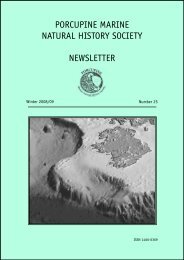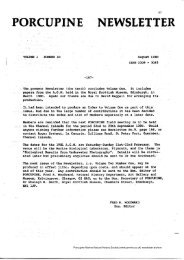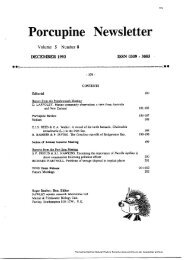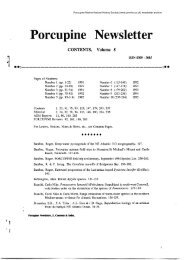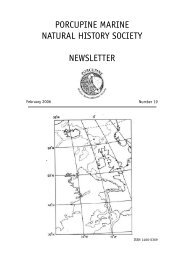PORCUPINE MARINE NATURAL HISTORY SOCIETY NEWSLETTER
PORCUPINE MARINE NATURAL HISTORY SOCIETY NEWSLETTER
PORCUPINE MARINE NATURAL HISTORY SOCIETY NEWSLETTER
You also want an ePaper? Increase the reach of your titles
YUMPU automatically turns print PDFs into web optimized ePapers that Google loves.
30<br />
are apparently suitable salt marshes. In the Menai<br />
Strait L. humile is abundant just inside the southwest<br />
entrance, but apart from an isolated colony<br />
4.5 Km in, does not extend far up the strait. The<br />
lack of spread in this channel is probably due to<br />
the timing of tidal currents. There are differences<br />
in tidal amplitudes and times of high water at the<br />
two ends of the strait so the flow begins to run<br />
south-westwards more than an hour before local<br />
high tide (Campbell et al, 1998). Thus, at the times<br />
when sea water covers the marshes drifting seeds<br />
would not go further up the strait. Furthermore there<br />
is a substantial net residual flow south-westwards.<br />
Elsewhere in the inlets of the south-west Anglesey<br />
coast, highest water levels, often coinciding with<br />
onshore winds would favour more seed retention.<br />
Tidal movements were shown by Boorman (1971) to<br />
play a key role in the export of Sea Lavender seeds<br />
from salt marshes.<br />
Figure B. Distribution of Limonium vulgare around<br />
Anglesey<br />
In contrast to Limonium humile, L. vulgare (figure<br />
B) is found on both sides of the island. Anomalously<br />
however it mainly occupies quite different habitats<br />
on the two coasts. On the north-east side, as would<br />
be expected, it occurs almost exclusively in salt<br />
marshes, but it is really abundant only in one small<br />
estuary, Traeth Dulas. This is a semi- enclosed tidal<br />
inlet with a narrow entrance, so once established,<br />
conditions should have favoured the long-term<br />
maintenance of the population. This contrasts with<br />
the smaller and more widely separated colonies in<br />
Red Wharf Bay, where conditions would have been<br />
more conducive to seed export, and loss from some<br />
monads seems to have occurred in recent decades. In<br />
some west coast marshes there are just a few earlier<br />
records of L. vulgare. Unusually however, on part<br />
of the south-west coast it grows exclusively in the<br />
crevices of splash zone rocks and amongst boulders.<br />
The particular section of coast where this occurs has<br />
a frontage of only about 5.5 km, within which there<br />
PMNHS Newsletter No.24 Summer 2008<br />
are about 6 discrete colonies. Given the atypical<br />
habitat, the very restricted spread and the particular<br />
vigour of these rock habitat plants, questions arise<br />
as to whether they might be genetically distinct from<br />
the salt marsh variety. If this is so from where, when<br />
and how did they get here?<br />
Figure C. Distribution of Limonium binervosum agg around<br />
Anglesey<br />
Forms of Limonium binervosum agg, (figure C) occur<br />
in both rocky coast and high level sandy salt marsh<br />
situations, and on both sides of Anglesey, but they<br />
are absent from both the predominantly rocky north<br />
coast and from the Menai Strait. The hottest spot for<br />
them is the west coast of Holyhead Island, particularly<br />
the section between Trearddur Bay and South Stack.<br />
Several morphologically distinguishable variants can<br />
be found. In places more than one of these variants<br />
occurs adjacent to each other, a feature that may<br />
be relevant to the history of colonisation. Rising<br />
sea levels and ecological roll back during the postglacial<br />
transgression could have a bearing on colony<br />
isolation. Not yet explicable is the occurrence of<br />
flourishing colonies in the sandy salt marshes at<br />
the mouth of the Cefni Estuary and on the tip of<br />
Llanddwyn Island, but an absence in apparently<br />
suitable habitats around Traeth Abermenai.<br />
None of the Sea Lavenders currently have distributions<br />
that extend further north than the extreme south<br />
west of Scotland and the north coast of Ireland<br />
(Preston et al, 2002). It must be assumed that<br />
climatic conditions did not ameliorate enough for<br />
them to colonise North Wales until some time after<br />
about 10,000 BP and probably after rising sea levels<br />
had separated Britain from the continent. Present<br />
day distributions often in discrete colonies with<br />
plenty of seedlings in them, suggest that successful<br />
medium and especially long range dispersal has<br />
been relatively infrequent. Nevertheless there must<br />
at times have been some longer distance spread<br />
of propagules to found the present colonies. With<br />
a few exceptions the flowering plants of the salt



